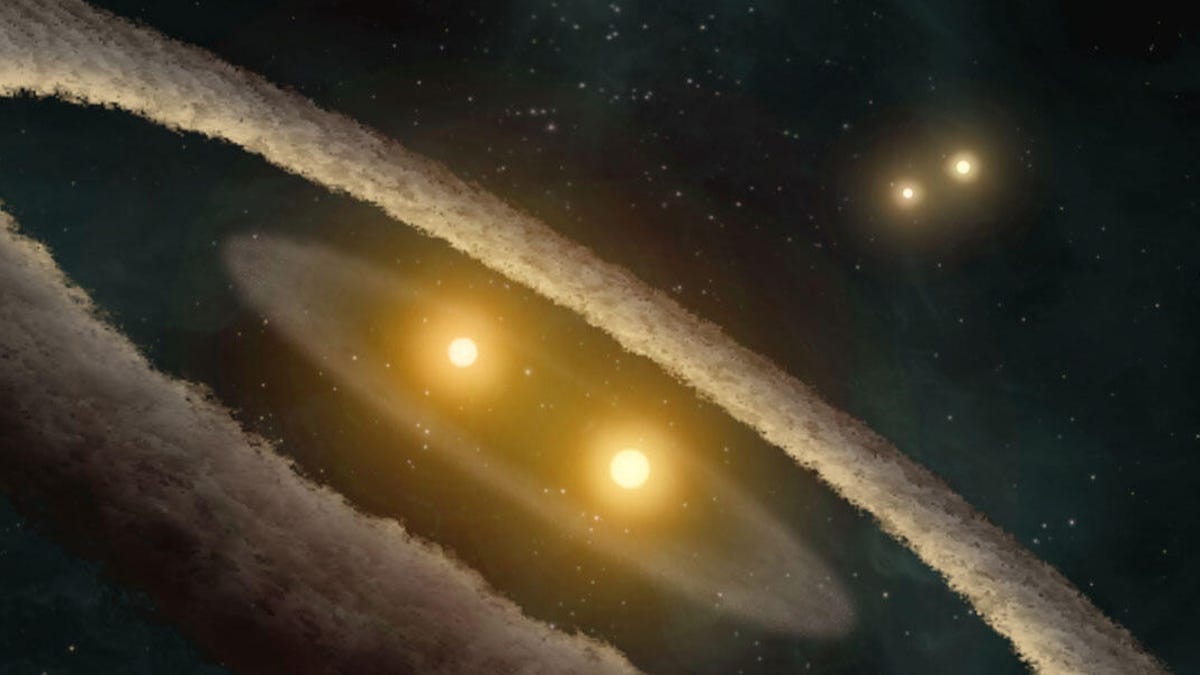Scientists Discover 'First of Its Kind' 3-Star System in Deep Space
And once upon a time there might've been a fourth.

Artist's interpretation of HD 98800, a quadruple-star system located 150 light-years away in the constellation TW Hydrae. Bin Liu and Alejandro Vigna-Gomez suggest that the more massive tertiary-star system TIC 470710327 could have started in a similar configuration.
Somewhere in the depths of our universe, a stellar ballet is underway.
Against the dark curtain of space, three enormous, glittering stars are locked in a dance by their own gravitational forces and aglow in their shared luminescence. Two blazing balls of gas are tightly pirouetting around each other, completing their mutual orbit to the rhythm of an Earth day. Simultaneously, a third star steadily encircles the pair, casting a spotlight on the performance.
Details of the cosmic situation can be found in a paper published in June in Monthly Notices of the Royal Astronomical Society.
"As far as we know, it is the first of its kind ever detected," Alejandro Vigna-Gomez, an astrophysicist at the University of Copenhagen and co-author of the paper, said in a statement Monday.
Though this animation is of a star and a black hole binary system, it helps illustrate what binary objects' motions would look like.
Even though we know of many tertiary star systems, per Vigna-Gomez, not only are they much farther apart than this sparkly trio, but they're also typically less massive. By quite a bit.
According to the new paper, the internal, close-quarter binary stars hold a combined mass approximately 12 times that of our sun, and the wide-field globe surrounding them boasts a whopping 16 times the mass of our sun. For context, it would take more than 330,000 Earths to match one solar mass, a quantity that comprises 99.8% the mass of our entire solar system. Simply put, these stellar ballerinas are absolutely colossal.
But in the grand scheme of things, Vigna-Gomez was after much more than merely identifying this unusual starry arrangement. The goal was to decode precisely how such a fierce triplet -- formally dubbed TIC 470710327 -- came together in the first place.
A missing ballerina
Along with fellow researcher Bin Liu, a theoretical astrophysicist also affiliated with the University of Copenhagen, Vigna-Gomez first came up with several options for the newly observed three-star system's backstory.
Foremost, there was the idea that the bigger, outer star formed first. However, this option eventually fell through because, after some investigation, the team realized such a starry leviathan would've likely ejected material inward that would disrupt the binary stars' formation. There wouldn't have been a trio. There'd have been gaseous rubble spilling in all directions.
Second, the team considered that the binary star dancers and third star spectator might've formed separately -- far away from each other -- then eventually have fallen together by some force of gravity. Though this particular scenario hasn't been totally ruled out yet, the researchers think it still might not be the best one. They're much more focused on the final and preferred possibility. A slightly less collaborative one.
What if two individual binary star systems formed near each other, the researchers wondered, then maybe one of those pairs merged into a giant star? If true, that massive combo star would be the outer one we see today, orbiting the smaller -- but still huge -- stars within.
In other words, it could be possible that a fourth dancer was part of this cosmic ballet, but was unfortunately eaten up by its own partner prior to the final scene. Well, as of the team's new research -- based on tons of computer models and fascinatingly rooted in the discoveries of citizen scientists -- this case was the most probable.
"But a model is not enough," Vigna-Gomez said, arguing that to prove his and Liu's suspicion with high certainty would require either using telescopes to study the tertiary system in better detail or statistically analyzing nearby star populations.
"We also encourage people in the scientific community to look at the data deeply," Liu said in a statement. "What we really want to know is whether this kind of system is common in our universe."

